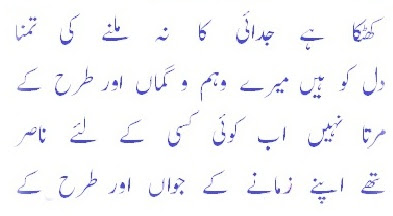Munir Ahmed Niazi | Biography
The Best of Munir Niazi
Munir Ahmed Niazi
 Munir Ahmad, better known as Munir Niazi, was an Urdu poet from Pakistan who also produced poetry in the Panjabi language.Niazi was born in Khanpur on 19 April 1928, a village near Hoshiarpur, India. He was from the Niazi tribe. He was initially educated at Khanpur and after the partition of India he migrated to newly independent Pakistan and settled in Sahiwal, where he passed his matriculation. He earned an intermediate degree from S.E. College, Bahawalpur and a B.A. from Diyal Singh College in Lahore, Pakistan.
Munir Ahmad, better known as Munir Niazi, was an Urdu poet from Pakistan who also produced poetry in the Panjabi language.Niazi was born in Khanpur on 19 April 1928, a village near Hoshiarpur, India. He was from the Niazi tribe. He was initially educated at Khanpur and after the partition of India he migrated to newly independent Pakistan and settled in Sahiwal, where he passed his matriculation. He earned an intermediate degree from S.E. College, Bahawalpur and a B.A. from Diyal Singh College in Lahore, Pakistan.Syed Nasir Kazmi
The Best of Nasir Kazmi
Syed Nasir Kazmi
 Syed Nasir Raza Kazmi, (1925–1972) was a renowned Urdu poet of Pakistan. He was one of the greatest poets of this era, especially in the use of "ista'aaray" and "chhotee beher". Kazmi was born on December 8, 1925 at Ambala in British India.
Syed Nasir Raza Kazmi, (1925–1972) was a renowned Urdu poet of Pakistan. He was one of the greatest poets of this era, especially in the use of "ista'aaray" and "chhotee beher". Kazmi was born on December 8, 1925 at Ambala in British India. Kazmi was educated at Ambala, Simla and Lahore. He returned to Ambala in 1945 and started looking after his ancestral land. After the creation of Pakistan in 1947, he came to Lahore.
He did some journalistic work with Auraq-e-Nau as an editor and became editor-in-chief of the magazine Humayun in 1952. Later he was associated with Radio Pakistan, Lahore and other literary publications and organizations.
Mirza Asadullah Baig Khan
The Best of Mirza Ghalib
Mirza Asadullah Baig Khan

Mirza Asadullah Baig Khan, pen-name Ghalib, ġhālib means dominant) and (former pen-name) Asad, asad means lion) (27 December 1797 – 15 February 1869), was a classical Urdu and Persian poet from India during British colonial rule. During his lifetime the Mughals were eclipsed and displaced by the British and finally deposed following the defeat of the Indian rebellion of 1857, events that he wrote of. Most notably, he wrote several ghazals during his life, which have since been interpreted and sung in many different ways by different people. He is considered, in South Asia, to be one of the most popular and influential poets of the Urdu language. Ghalib today remains popular not only in India and Pakistan but also amongst diaspora communities around the world.
Mir Taqi Mir | Biography
The Best of Mir Taqi Mir
Mir Taqi Mir
 Born in Agra, India (then called Akbarabad), ruled by the Mughals at the time. He left for Delhi, at the age of 11, following his father's death. His philosophy of life was formed primarily by his father, whose emphasis on the importance of love and the value of compassion remained with him throughout his life and imbued his poetry. At Delhi, he finished his education and joined a group of nobility as a courtier-poet. He lived much of his life in Mughal Delhi. Kuchha Chelan, located in famous grain market Khari Baoli, in Old Delhi was his address at that time. However, after Ahmad Shah Abdali's sack of Delhi each year starting 1748, he eventually moved to the court of Asaf-ud-Daulah in Lucknow, at the king's invitation. Distressed to witness the plundering of his beloved Delhi, he gave vent to his feelings through some of his couplets.
Born in Agra, India (then called Akbarabad), ruled by the Mughals at the time. He left for Delhi, at the age of 11, following his father's death. His philosophy of life was formed primarily by his father, whose emphasis on the importance of love and the value of compassion remained with him throughout his life and imbued his poetry. At Delhi, he finished his education and joined a group of nobility as a courtier-poet. He lived much of his life in Mughal Delhi. Kuchha Chelan, located in famous grain market Khari Baoli, in Old Delhi was his address at that time. However, after Ahmad Shah Abdali's sack of Delhi each year starting 1748, he eventually moved to the court of Asaf-ud-Daulah in Lucknow, at the king's invitation. Distressed to witness the plundering of his beloved Delhi, he gave vent to his feelings through some of his couplets.Mir migrated to Lucknow in 1782 and remained there for the remainder of his life. He died, of a purgative overdose, on Friday, 21 September 1810. The marker of his burial place was removed in modern times when a railway was built over his grave.
Subscribe to:
Posts (Atom)



































.JPG)










